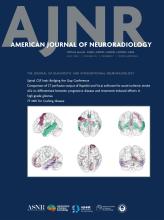What great discussions have been sparked by a recent American Journal of Neuroradiology article from Ivanovic et al.1 We used this article in a recent neuroradiology journal club at Emory University, and it came up during the 2024 Stanford Radiology Improvement Summit, February 22–23, 2024, Stanford, California. I would like to share some thoughts that came up during these events.
The initial reaction to the article is one of surprise and disbelief. There is a certain audacity in stating that 19–26 cross-sectional imaging studies per neuroradiologist per day are associated with lower error rates. In the current practice environment, it seems impossible to imagine putting a specific number to it, or is it?
Have we been slowly conditioned to tackle increasing volumes across the years? How much of our ability to manage higher volumes is related to cutting corners, such as skipping the medical chart review, looking at fewer priors, scrolling faster, relying on trainee initial reads and reporting, worrying less about catching incidental findings, and taking a narrower approach informed by the clinical context rather than a comprehensive interpretation?
It may be good to have this number out there when it comes to negotiating for more FTEs. However, most practices find that there are currently not enough radiologists in the recruiting pool. Unable to hire up, we are becoming creative in tackling high clinical demands in other ways. The discussions I participated in listed several interventions, real and theoretic: Schedule shifts to match volumes, accept backlogs, shut down scanners/decrease outpatient imaging volumes to match radiologist reading capacity, allow radiologists to stay within certain limits (hours of work, work relative value units), call backup readers to jump in for an hourly fee, further increase radiologists’ efficiency by eliminating noninterpretive tasks and “efficiency rounding,” and reduce the number of images in a study.
Most important, we need to make up our own rules and approaches within our practices or larger organizations. Regulators have no business regulating how we serve our patients, and the American College of Radiology has no interest in prescribing volume caps for radiologists. If errors become a costly issue, payors and malpractice insurers may develop an opinion, but there is no evidence of this issue now. Maybe the use of radiology-pathology correlations, second reads, or future artificial intelligence (AI) applications can help us get data that inform our true error rates in radiology and the impact those errors have on our patients.
Using daily quotas can result in a race to the bottom. Nobody wants that. Some radiologists can safely read more studies, others less. We need a solution for managing high volumes in the safest way possible. AI applications are evolving but are not quite to a point at which they reduce our workload considerably. This is a wake-up call, and yes, we can!
Footnotes
Disclosure forms provided by the authors are available with the full text and PDF of this article at www.ajnr.org.
Reference
- 1.↵
- © 2024 by American Journal of Neuroradiology












